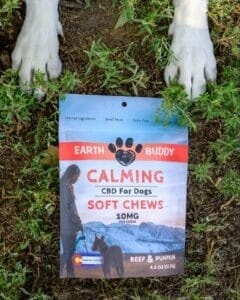When you walk into the dog food aisle, there are usually bags upon bags of food stacked up and down both sides. With so many choices in pet food, selecting the best nutrition for your furry friend can be a bit overwhelming. Among the options, grain-free dog food has seen a surge in popularity, backed by various claims about its benefits for canine health. But what is grain free dog food? And why should dog owners make the switch from regular dog food to grain free diets?
What Is Grain-Free Dog Food?
Before we dive into the benefits, let’s clarify what “grain-free” really means. Grain-free means that the food does not contain most grains and may or may not be gluten free. Grains are seeds of grassy plants, and they include wheat, corn, rice, barley, oats, rye, and millet, among others. In the context of pet food, particularly dog food, grain free diets are formulated without these grains as a source of carbohydrates.
It’s important to note that “grain-free” does not necessarily mean low-carbohydrate or low-starch. The alternative carbohydrate sources used in grain-free diets are still carbohydrates.
Instead, grain free foods incorporate alternative carbohydrate sources such as sweet potatoes, peas, or lentils. Grain free dog diets are usually higher in protein and fat, which mimics a more ancestral diet for dogs.
Grain Free Dog Food Promotes Digestion
Grain free dog food can support normal digestive function in many pets. By eliminating grains, these formulas can soothe skin-related issues and support healthy digestion in dogs that may experience complications with common grains like wheat, corn, and soy. The absence of such grains means that the food typically contains more protein and animal fats, which are more biologically appropriate and easier for dogs to digest.
Additionally, many grain free dog diets are enriched with fiber-rich vegetables and fruits, which support normal digestive function by promoting normal bowel function and balancing the animal’s intestinal microflora. As a result, grain-free dog food, generally without gluten containing grains, may support and promote long term health in dogs.
Enhanced Nutritional Value In Grain Free Dog Food
In comparison to regular dry dog food, grain-free options often boast an enhanced nutritional profile, focusing on providing high-quality, easily digestible proteins and a variety of fruits and vegetables. Without grains, these diets typically have lower carbohydrate content and higher protein levels, aligning more closely with a dog’s natural dietary needs.
The incorporation of nutrient-dense ingredients like sweet potatoes, peas, and berries ensures a rich supply of essential vitamins, minerals, and antioxidants in a dog’s food, helping maintain optimal health. Furthermore, many grain-free foods contain beneficial fats such as omega-3 and omega-6 fatty acids, which support skin and coat health, enhance the immune response, and help support cognitive function.
Weight Management With Grain Free Foods
Grain-free dog food can be a valuable option for supporting proper weight management, owing to its typically higher protein content and lower carbohydrate levels compared to regular dog food. Higher protein levels can promote lean muscle mass and support a healthy metabolism, both of which are essential for supporting proper weight management. Furthermore, the reduced carbohydrate content supports weight loss and a healthy appetite, as excessive carbohydrates can be stored as fat.
Grain-free dog foods often contain more fiber-rich vegetables and fruits, which can help maintain satiety and help maintain blood glucose levels within a normal range. The incorporation of healthy fats, such as omega-3 fatty acids, can further help support energy production at a cellular level. Overall, when portioned appropriately, grain-free dog food can help maintain the general health of all ages and breeds.
Grain Free Foods For Skin and Coat Health
Grain-free dog food can play a significant role in supplying nutrients for a healthy coat, primarily because of its typically higher content of quality proteins and beneficial fats, such as omega-3 and omega-6 fatty acids. These essential fatty acids are pivotal in helping maintain the normal moisture content of the skin, promoting a healthy inflammatory response, and fostering a glossy, healthy coat.
The absence of grains also provides support for animals with sensitive skin that experience adverse food reactions. Incorporating a variety of fruits and vegetables into grain-free formulas provide a diet rich in omega fatty acids, vitamins, and minerals essential for nutritional support for healthy coats and antioxidants.
These ingredients further support skin health by assisting the body in combating environmental pollutants. As a result, dogs on well-balanced, grain-free diets have helped reduce unseasonal or excessive shedding.
Is Grain Free Dog Food Hypoallergenic?
Grain-free dog food is not inherently hypoallergenic. “Hypoallergenic” refers to products that are less likely to cause allergic reactions. Grain-free dog foods exclude grains such as wheat, barley, and oats, but they may contain other ingredients that may not agree with your dog’s body, such as beef, chicken, dairy, or eggs.
Grain free diets were initially developed for dogs with food allergies or grain allergies. However, many grain free foods substitute grains with alternative carbohydrate sources like potatoes or legumes, which can also be problematic for some dogs.
If you suspect your dog has a food allergy, it is essential to work closely with your veterinarian to identify the specific allergen. They may recommend an elimination diet to determine the cause of the allergic reaction and suggest a suitable hypoallergenic diet tailored to your dog’s specific needs. Keep in mind that each dog is unique, and what is hypoallergenic for one dog may not be for another.
Finding Quality Grain Free Dog Food
Grain free dog foods are not universally made, and, as such, the ingredients and quality of the ingredients vary. When searching for grain-free dog food, meticulously examining the ingredient list is imperative. This step is vital as it reveals the primary components of the food, thereby enabling you to assess its nutritional value and suitability for your pet. High-quality grain-free dog foods should feature a source of animal protein as the first ingredient, ensuring that your pet receives the essential amino acids for optimal health.
Moreover, the inclusion of fruits, vegetables, and healthy fats is desirable for a balanced diet, providing essential vitamins, minerals, and fatty acids. Equally important is the identification and avoidance of products containing unnecessary fillers, artificial additives, and preservatives, which could negatively impact your pet’s health.
Scrutinizing the ingredient list allows you to make an informed decision, ensuring that the selected food meets the dietary needs and preferences of your dog while promoting overall well-being.
Does Grain Free Dog Food Still Contain Amino Acids?
Grain free dog food, like any quality dog food, should contain all the essential amino acids that dogs need for optimal health. Amino acids are the building blocks of proteins, and dogs require 22 amino acids, 12 of which they can produce internally. The remaining 10 essential amino acids must be provided through their diet. These essential amino acids include arginine, histidine, isoleucine, leucine, lysine, methionine, phenylalanine, threonine, tryptophan, and valine.
Grain free dog foods typically utilize alternative protein sources such as meat, fish, eggs, legumes, and vegetables to meet a dog’s amino acid requirements. It’s crucial to ensure that the grain free dog food you choose is high-quality and well-formulated to provide a balanced and complete nutritional profile.
What Does Complete and Balanced Mean?
Complete and balanced nutrition is crucial for a dog’s overall health and well-being. A diet that is “complete” means it contains all the essential nutrients your dog needs in the correct proportions, while “balanced” refers to the appropriate ratio of these nutrients relative to the caloric content of the food.
These nutrients include proteins, fats, carbohydrates, vitamins, minerals, and water. High-quality proteins promote muscle integrity and definition, fats support energy production, and carbohydrates help support energy production. Vitamins and minerals support a normal metabolic rate, promote healthy cellular activity, and help build and maintain bones and teeth.
A complete and balanced diet also assists in the digestion and absorption of essential nutrients, enhances the immune response, and helps maintain healthy skin and coat. It’s advisable to look for dog foods that adhere to the nutritional guidelines set by the Association of American Feed Control Officials (AAFCO) to make sure your pet is getting a balanced diet.
Understanding the Risk of BEG Diets
“BEG” diets for dogs refer to dog diets that are high in “boutique, exotic ingredients, or are grain free.” These diets became popular as pet owners started looking for more natural and high-quality food options for their pets, often featuring unusual protein sources like kangaroo, alligator, or venison and replacing grains with ingredients like sweet potatoes, peas, or lentils.
However, it’s important to note that the U.S. Food and Drug Administration (FDA) has been investigating a potential link between BEG diets and a type of canine heart disease. Some veterinary medicine research suggests that these diets may lack certain nutrients necessary to support the normal function of the cardiac muscle, but more research is needed to fully understand the relationship between heart disease and these types of pet foods.
Pet owners considering BEG diets should have a thorough discussion with their veterinarians to ensure that any diet chosen meets the individual nutritional needs of their pet, and they should be vigilant about monitoring their pets for any signs of health issues, especially if they are feeding a BEG diet. Regular check-ups from a professional in veterinary medicine and a balanced, well-rounded diet are crucial for supporting and promoting long-term health.
Don’t Let The Pet Food Bag Fool You
It’s essential for pet owners to exercise discernment when selecting dog food, as attractive packaging does not necessarily equate to nutritional value. The market is replete with dog food brands featuring well-designed, appealing bags adorned with images of fresh meat, vibrant vegetables, and luscious fruits, intending to convey health and wholesomeness. However, the actual contents may not always align with the external portrayal.
Some products may contain suboptimal ingredients, fillers, artificial additives, or insufficient nutrients, despite their outward appearance. Therefore, pet owners are encouraged to scrutinize the ingredient list, research the brand, and consult their veterinarian to ensure that the chosen food meets their dog’s specific nutritional needs, rather than relying solely on the allure of the packaging.
Grain Free Calming Chews Limited Ingredient From Earth Buddy
The grain free calming chews for dogs from Earth Buddy are crafted with straightforward, trustworthy ingredients, making them suitable for your pet’s daily consumption. These chews are flavorful and free of the sugary binders that are commonly found in other soft chews for dogs.
Dog calming chews with limited ingredients are essentially crafted with a reduced number of components, typically featuring a singular primary ingredient, be it a source of protein or a nutritious vegetable. Often, these treats are grain free, eliminating the usual fillers found in many dog treats.
Utilizing such treats can streamline your dog’s dietary intake, facilitating a clearer understanding of what they consume. This refined formulation aids in the digestion and absorption of essential nutrients, promoting gastrointestinal health. Additionally, it provides pet owners with enhanced control over their pets’ nutritional intake by ensuring transparency regarding their dog’s food and treats.
In addition to being limited ingredient and grain free, Earth Buddy’s Calming Chews for dogs also contain full-spectrum CBD. Each Calming Chew contains 5mg of full spectrum hemp extract for dogs if you choose the Duck & Apple or 10 mg in the Beef & Pumpkin.
Full Spectrum Hemp Extract and Digestion
Full spectrum hemp extract interacts with the endocannabinoid system (ECS), which plays a crucial role in promoting homeostasis in the body, including the regulation of digestive processes. By modulating the ECS, full spectrum hemp extract may help maintain a normal inflammatory response in the digestive tract, work as a digestive aid, and support normal bowel function, thereby supporting a healthy gut.
For further reading, we recommend:
- https://www.ncbi.nlm.nih.gov/pmc/articles/PMC10212094/
- https://www.fda.gov/animal-veterinary/animal-health-literacy/complete-and-balanced-pet-food
- https://www.fda.gov/animal-veterinary/outbreaks-and-advisories/fda-investigation-potential-link-between-certain-diets-and-canine-dilated-cardiomyopathy
- https://www.ncbi.nlm.nih.gov/pmc/articles/PMC8100497/
- https://www.researchgate.net/publication/351480317_Comparison_of_digestibility_parameters_of_commercial_dry_dog_foods_with_different_contents
- https://journals.plos.org/plosone/article?id=10.1371/journal.pone.0250806
- https://www.sciencedirect.com/science/article/pii/S2405654518303081
- https://www.ncbi.nlm.nih.gov/pmc/articles/PMC3232190/
- https://www.frontiersin.org/articles/10.3389/fncel.2022.867267/full
You Might Also Enjoy
Your dog’s skin is their largest organ making dog skin care a crucial part of…
Like us, our dogs, and other mammalian species, cats have an endocannabinoid system. This system…
Learning how to calm a dog down is an essential skill to have in your…






